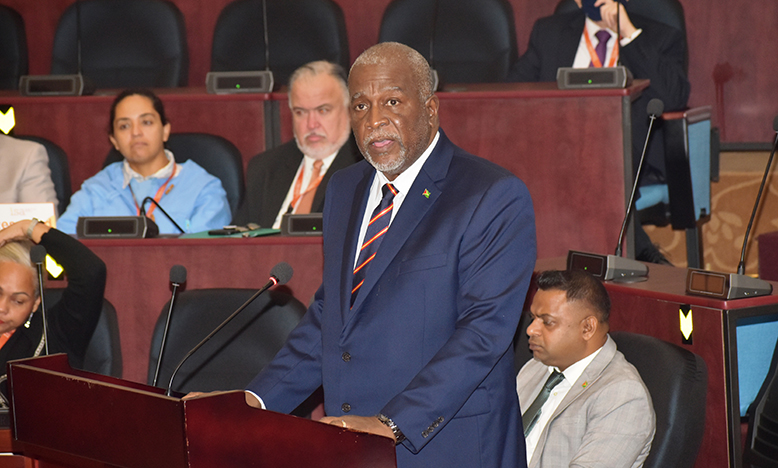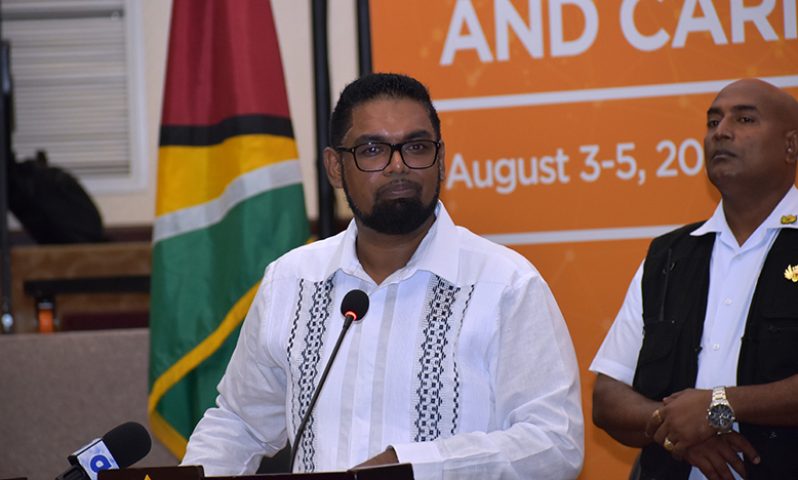– President Ali tells Latin America, Caribbean energy officials
IT is no secret that Guyana and the Caribbean have vast potential for renewable energy development.
With that in mind, there has been significant progress, locally and regionally, towards transforming the solar-energy capacity, and promoting sustainable energy access, energy security and effective energy management.
This has happened despite the challenges of affordability, lack of technological infrastructure and framework viability to facilitate large-scale projects.
During the 4th regional committee meeting of the Latin America and Caribbean arm of the International Solar Alliance at the Arthur Chung Conference Centre (ACCC), Liliendaal, Greater Georgetown, on Thursday, President, Dr Irfaan Ali underscored the value of discussions on renewable energy to answer critical questions relating to the Caribbean Community (CARICOM)’s transition to cleaner energy.

Presently, the sustainable energy market for CARICOM is at an estimated total of US$16 billion.
In order for the region to unlock its potential, drive an increase of renewable energy sources and meet set renewable targets, CARICOM needs to invest US$11 billion over the next 10 years, President Ali said in his featured address.
“Today’s meeting is occurring against the backdrop of transitions at the global, regional and national levels… the transition is not a cheap process,” said President Ali, adding: “We have not mastered the technology, nor have we been able to demonstrate from a financial and economic model that any singular-model application is sustainable in the long run.”
President Ali stated that CARICOM has the opportunity to create a renewable energy hub; however, countries in the region need an economically viable plan, as well as the financing, to advance major energy projects.
As it currently stands, CARICOM member states share a commitment that 47 per cent of the region’s energy source will come from renewable energy by year 2027.
Dr Ali highlighted that the region’s use of solar energy sources will help to decrease oil imports and high emission levels which contribute to climate change.
Furthermore, President Ali said regional policymakers from the Latin America and Caribbean energy corridor have an onus to examine the current energy-related realities and advance holistic discussions on the topic.

In this regard, he noted policymakers need to focus on achieving long-term sustainable development and energy-supply solutions against finding short-term beneficial solutions. For the President, the primary focus is on maintaining the region’s low-carbon pathway and climate resilience.
His Excellency indicated that the solutions-oriented discussions on renewable energy or solar energy is underscored by the importance to develop and implement a detailed, comprehensive and transparent plan on achieving regional sustainability.
This plan should, he noted, prioritise economic, legal, political and social parameters that span several areas.
These areas include affordability of renewable energy; importance, ownership and use of solar energy technology; assessing whether solar energy is market-driven or a social good; good economic positioning; and environmental impacts, to name a few.

There is also an urgent need for financing of effective adaptation and mitigation measures within the region’s energy landscape.
President Ali emphasised that addressing regional challenges on the transition to renewable energy is crucial to the Caribbean’s economic growth.
Additionally, Minister within the Ministry of Public Works, Deodat Indar, who convened Thursday’s regional meeting, said that Guyana continues to be at the forefront of leadership in the renewable energy sector.
Minister Indar said that, the country’s implementation of the Low Carbon Development Strategy (LCDS) 2030 is a nationwide vision to achieve socio-economic development within a low-carbon and climate-resilient economy.
In addition, he highlighted that in recent times Guyana, Latin America and the Caribbean have been engaged in tremendous work on renewable energy.
Moreover, Dr Ajay Mathur, Director-General of the International Solar Alliance (ISA), indicated that Guyana joins countries such as Jamaica, Chile, Cuba, Nicaragua and Peru to experience rapid increases over the years in the territory’s solar power photovoltaic (PV) capacity.

Dr Mathur expressed the ISA’s commitment to future regional collaborative action on renewable energy and pledged the organisation’s support toward providing resources and support to build capacity for solar energy projects, and to continue making solar energy a preferred option within the region.
In his remarks, Prime Minister of Guyana Mark Phillips said the contributions of the ISA are vital to fostering strategic partnerships, grounded in the regional agenda on clean-energy transitions and deployment of solar energy technologies.
The Prime Minister noted that the energy development projects underway in Guyana will include enhancing energy access through investments in solar photovoltaic (PV) systems and off-grid areas, as well as expanding the Hinterland Electrification Programme that will see upgrades and replacements to the previously installed solar photovoltaic systems, to name a few.
Without doubt, Guyana, Latin America and the Caribbean continue to strive toward achieving Sustainable Development Goal 7 to ensure that households within the region have access to affordable, reliable, sustainable and modern energy.
The regional meeting on Thursday saw in attendance ministers of the Government of Guyana, energy officials and delegates, and members of the diplomatic community. It is slated to be held from August 3 to August 5, 2022.




.png)









